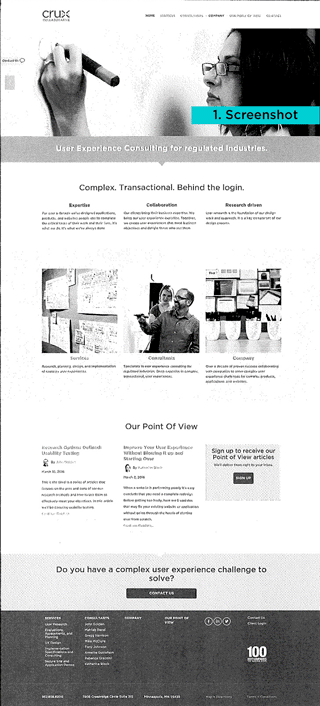Overcoming Sketching Anxiety: Why it doesn’t matter if you can’t draw
There is often a sense of excitement amongst our clients when we introduce them to the idea of collaborative design concepting.
Perhaps participating in a group sketching session evokes childhood memories of doodling with crayons or it could be that it just sounds more fun than another afternoon in the office. In either case, the initial nostalgia and excitement about the idea is sometimes overshadowed by a wave of self-consciousness or dread when it comes to doing the work. When you “don’t consider yourself an artist”, it’s easy to feel overwhelmed and anxious about your ability to draw.
We’re going to let you in on a little secret about how sketching with us works; it doesn’t matter if you “can’t draw” for you to contribute great ideas to the process.
We are looking for you to bring knowledge of your product, your business objectives, and the constraints of your data and technical environments. The objective of our time sketching together is to collaboratively generate, vet, and refine multiple ideas for the interface, not draw pretty pictures.
Using this low-fidelity technique, we can quickly explore many possible solutions for the interface, before agreeing on a concept and moving onto detailed wireframes and a polished visual design.
If you aren’t familiar with the collaborative design process, it may be helpful to read a more in-depth article about it before we dig into the details in this article.
Needless to say, there is often some trepidation and anxiety:
Common Concerns We Hear
We’ve heard sketching anxiety manifest itself in a number of ways:
- “I can’t draw.”
- “I don’t have any ideas to contribute. You guys are the creative folks.”
- “I don’t know anything about designing websites.”
- “I don’t know how to draw what’s in my head.”
- “My drawing is going to be so bad, no one will understand my idea.”
If any of these thoughts have crossed your mind, we hope this article alleviates your concerns and helps you get excited to use sketching as a concepting tool.
The Goal of Sketching
Sketching is a process by which we combine your knowledge of your product and business with our user experience expertise. The purpose of sketching is to generate a lot of ideas— it’s kind of like the lottery, the more ideas that we have, the better chance there is that one of them will be a winner.
We use this methodology because drawing is the quickest possible way to get ideas out of your head and in front of the team where they can be evaluated, refined, and prioritized.
We collectively identify solutions that are the most compelling and discard those that won’t or can’t work—that’s the beauty of having product, design, and technical people in the same room, solving the same problem.
Since a sketching session involves representatives from multiple disciplines, the entire team has a strong sense of ownership of the final result because they actively participated in the ideation phase. Having key decision makers in the room also helps us narrow down the preferred approaches more quickly.
One of the indirect benefits of the methodology is the sense of ownership that those who were involved in the process have for the interface. Because they helped create it, they are more inclined to evangelize its merits to the broader organization.
The Advantage of Sketching
Without sketching, Crux Collaborative is forced to delve into the details of the interface without direct access to the people responsible for the data and requirements. We are left to guess how to transform a feature set into a framework and then how to incorporate details into that framework without the participation of the client team. If the first time a client is seeing both the approach you’ve taken to the framework of the interface as well as page-level details, it rarely goes well. There’s too much information to take in and provide feedback on.
When we sketch together, the overall approach is known and understood by the full team. The first wireframe review shift from being the moment at which you are introduced to the interface idea for the first time, to the moment at which you are able to see how page-level details and interactions appear within the established framework.
It may seem like a “extra” step, but sketching saves a ton of project time and budget by aligning teams on the big picture details, resulting in design and development phases that proceed smoothly and without those frustrating “gotcha” moments when a stakeholder sees a design for the first time and points out why the approach that was taken won’t work.
Now that we’ve addressed the “what” and “why” of sketching, lets talk about how sketching accomplishes these goals and why you can sketch even if you “can’t draw”.
We Get Inspired
Before the first round of sketching, we do some preparation work to orient the team. First, we review the objectives, requirements, and feature set of the application. Then, we take a look at example sites, tools, and applications that the team has gathered as inspiration for the session. These examples are provided by both our team and your team and can be competitor sites, interesting visual designs, or interactive tools. We take some time to explain to each other what we’ve brought as inspiration and why. This helps get the creative juices flowing before we start sketching. If you are worried that you won’t have any ideas, don’t worry because you will after we’ve reviewed all the inspiration examples.
We Focus on High-Level Problem Solving
When we start sketching, everyone is encouraged to think about their ideas at a high-level without getting bogged down in the details. You don’t have to account for every detail on the site because later phases of the project will go through the feature list with a fine-toothed comb. Our process encourages you to explore ideas without limiting your initial thinking, which frees up your brain to be creative without doubts.
We Use Low Tech Tools and a Visual Language
Using a low-fidelity process like sketching enables participants to contribute to the ideation process without having to know how to use complex design software or write a line of code. Sketching has a very low barrier to entry because it relies on a few basic tools to solve problems.
We also use a limited set of markers, two sketching templates, and specific visual language that enables the sketch to be about the idea and not the execution. Because almost anyone can use markers and paper, the project benefits from a wider range of expertise.
We Critique Concepts, not Coloring
After the first round of sketching is complete, everyone posts their sketches on the wall and presents their ideas to the group. Then we discuss the concepts and highlight the ideas that resonated strongly with the team.
It is important to be aware that the quality of your sketches is irrelevant. The sketches are used as a springboard for discussion, but are not the subject of artistic critique. Because the visual language levels the playing field, ideas are not judged by the craftsmanship of the sketch but by their capacity to solve the interface problems defined in the beginning of the session.
While the group discusses the ideas, we identify and collect themes on post-it notes. These themes are used to inform the next round of sketching as well as the high-fidelity wireframes during later phases of the project. The sketches are conversation starters—they aren’t intended to be design-ready masterpieces.
We Collaborate for Success
One of our favorite things about sketching is the drastic evolution that takes place between the first and second round of concepting. Following round one, the team is invigorated by the energy of collaboration and they start to see why this process is likely to yield successful result.
Then we take what we learned and apply it to the round two sketches — layouts are refined, and interactions are explored in more depth. The group benefits from the sharing of ideas and energy.
Tips and Tricks:
Here are some suggestions that may make your first experience with our sketching process more enjoyable:
- Spend some time before the session familiarizing yourself with the website or application the team will be sketching around and review the inspiration you’ve found. Think about current challenges the site has and see how other companies are solving them.
- This includes non-competitors. Forms, newsletter sign-ups, stepped processes, and other interactions are used in just about any industry. You don’t have to limit your inspiration to only your competitors.
- Remember, this is not a test of your drawing ability. You will have an opportunity to talk everyone through your concepts.
- Have a list of critical features and content handy so you remember what you want to include.
- Focus on a specific problem to solve, such as a particular page or user flow.
- Use multiple “screens” to walk through a process from start to finish.
- Ask yourself questions about a sketch and explore the answer in another sketch:
- What happens when the user clicks on this functionality?
- How else could content display on this page?
- What does a detail level page look like?
- What does the rest of this process look like?
- The more you sketch, the easier it will become. It’s okay if you cross a sketch out and start over, we’ll have plenty of paper available.
Try This Simple Exercise:
Here’s something you can do before a sketching session that can help you get over the anxieties you may have about sketching by giving you an idea of what the end result is.
You can do this exercise at your desk with a pen or sharpie and a highlighter (optional):
- Take a screenshot of a page from a website and print it out in black and white.
- Using a pen or sharpie, draw boxes around images and label features and content.
- If you have a highlighter, color over the most important elements on the page to make them pop.

This simple exercise can help shake off the fear of “not being able to draw” and get you thinking with the right mindset of low-fidelity and high-level problem solving. It will also set your expectations of what sketches will look like.
We hope these suggestions make you feel more empowered to participate in a sketching session with us. Contact us to learn more about how your site or application can benefit from our sketching process.
Related Insights
-
Budget constraints are real, and teams are being asked to do more with less all the time. But, failing to meet certain expectations can result in disappointed customers, regulatory or legal hassles, competitor disruption, and loss of business. -

How to Get to Consensus Quickly with Sketching
When you’re ready to embark on a project, sketching or collaborative concepting can help get your team on the same page quickly. Gathering a cross-functional team to dig into the aspects of a few sections of your interface will help the team make decisions and move forward quickly from a common vantage point. -
Bridging The Knowledge Gap – Project Discovery
Project discovery sets the stage for the rest of your project. Learn about some of the tools we use at Crux Collaborative for effective project discovery.
